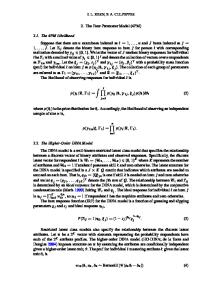A Dyadic IRT Model
- PDF / 615,755 Bytes
- 22 Pages / 547.087 x 737.008 pts Page_size
- 84 Downloads / 373 Views
A DYADIC IRT MODEL
Brian Gin UNIVERSITY OF CALIFORNIA, SAN FRANCISCO
Nicholas Sim UNIVERSITY OF CALIFORNIA, BERKELEY
Anders Skrondal NORWEGIAN INSTITUTE OF PUBLIC HEALTH UNIVERSITY OF OSLO UNIVERSITY OF CALIFORNIA, BERKELEY
Sophia Rabe- Hesketh UNIVERSITY OF CALIFORNIA, BERKELEY
We propose a dyadic Item Response Theory (dIRT) model for measuring interactions of pairs of individuals when the responses to items represent the actions (or behaviors, perceptions, etc.) of each individual (actor) made within the context of a dyad formed with another individual (partner). Examples of its use include the assessment of collaborative problem solving or the evaluation of intra-team dynamics. The dIRT model generalizes both Item Response Theory models for measurement and the Social Relations Model for dyadic data. The responses of an actor when paired with a partner are modeled as a function of not only the actor’s inclination to act and the partner’s tendency to elicit that action, but also the unique relationship of the pair, represented by two directional, possibly correlated, interaction latent variables. Generalizations are discussed, such as accommodating triads or larger groups. Estimation is performed using Markov-chain Monte Carlo implemented in Stan, making it straightforward to extend the dIRT model in various ways. Specifically, we show how the basic dIRT model can be extended to accommodate latent regressions, multilevel settings with cluster-level random effects, as well as joint modeling of dyadic data and a distal outcome. A simulation study demonstrates that estimation performs well. We apply our proposed approach to speed-dating data and find new evidence of pairwise interactions between participants, describing a mutual attraction that is inadequately characterized by individual properties alone. Key words: item response theory, social relations model, dyadic data, Markov-chain Monte Carlo, Stan.
1. Introduction How individuals interact within a group has been and continues to be of interest to researchers in the behavioral sciences. A model developed to handle the simplest case of two individuals interacting in a dyad is the Social Relations Model (SRM) (e.g., Warner et al. 1979; Kenny and La Voie 1984), also known as the complete SRM to distinguish it from a popular constrained version called the basic SRM (see Sect. 2.4 on variants of the SRM). Here, the ways one individual Electronic supplementary material The online version of this article (https://doi.org/10.1007/s11336-02009718-1) contains supplementary material, which is available to authorized users. Correspondence should be made to Nicholas Sim, University of California, Berkeley, 2121 Berkeley Way, Berkeley, CA94720, USA. Email: [email protected]
© 2020 The Psychometric Society
PSYCHOMETRIKA
(often called an actor or perceiver) of a dyad behaves when paired with the other (often called the partner or target) and vice versa are analyzed to infer individual-level and dyad-level effects. The behavior of the actor can be directed tow
Data Loading...











